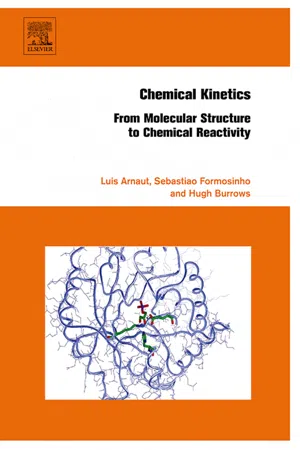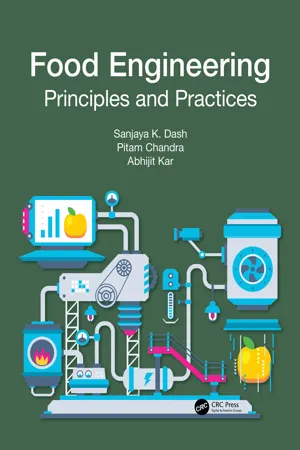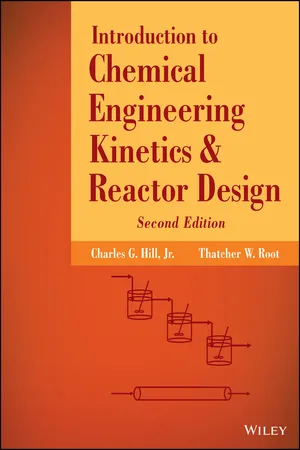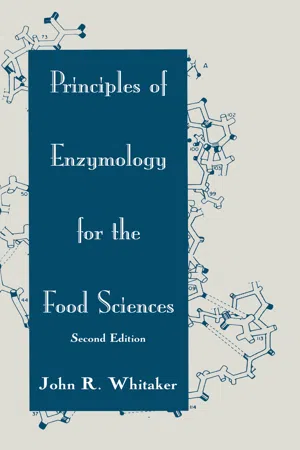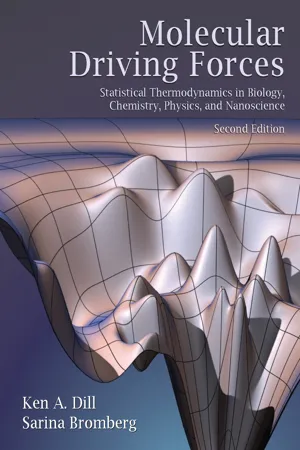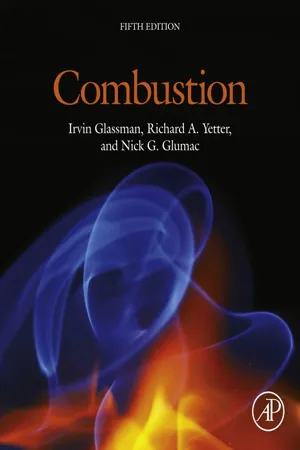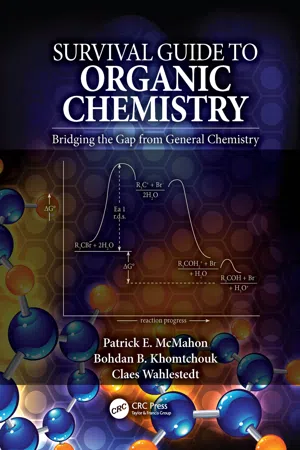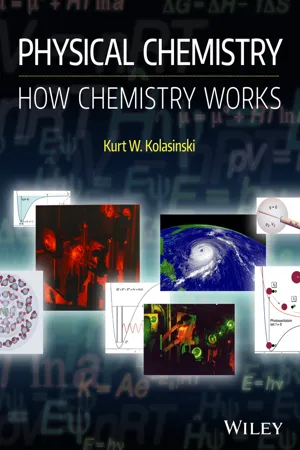Chemistry
Rate of Reaction and Temperature
The rate of a chemical reaction generally increases with temperature. This is due to the higher kinetic energy of the particles, leading to more frequent and energetic collisions. As a result, more successful collisions occur, leading to a faster rate of reaction. Conversely, decreasing the temperature typically slows down the rate of reaction.
Written by Perlego with AI-assistance
Related key terms
11 Key excerpts on "Rate of Reaction and Temperature"
- eBook - ePub
Chemical Kinetics
From Molecular Structure to Chemical Reactivity
- Luis Arnaut, Hugh Burrows(Authors)
- 2006(Publication Date)
- Elsevier Science(Publisher)
2Reaction Rate Laws
Publisher Summary
This chapter discusses the factors involved in determining the rates of chemical reaction. The velocities of elementary chemical reactions depend on a number of factors, in particular the nature of the reactants, concentrations or pressures, temperature, light, catalysts, and the solvent used. The great variation observed in reaction velocities is related first to the nature of the reagents. Secondly, all reaction rates depend on the concentration of reagents, while for reversible reactions those of products also affect them. These reactions also depend on rate constant and temperature; the temperature dependence comes from the exponential term. The effect of light on chemical reactions is well known from the processes of photosynthesis and photography. Catalysts do not alter the position of equilibrium in a reaction. Their effect, instead, arises from the fact that in their presence a pathway with lower activation energy becomes available to the reactants.2.1 REACTION RATES
The rate of conversion for the general form of a chemical reaction,(2.I)v AA +v BB + ⋅ ⋅ ⋅ →v XX +v YY + ⋅ ⋅ ⋅(2.I)where v A , v B , v X and v Y are the stoichiometric coefficients of the species involved, can be expressed in terms of a single parameter ξ, which is known as the extent of reaction, and is defined by [1]ξ =(2.1)n i( ξ ) −n i( 0 )v i(2.1)Here, i represents any of the reactants or products,nithe number of moles of i in the chemical reaction (positive for products and negative for reactants),ni(0) the amount of i present when v = 0 (that is before the start of the reaction) andni(ξ) the amount of i present at extent of reaction ξ.The rate of conversion in a chemical reaction is defined as the variation of ξ with time, t ,r =(2.2)d ξd t(2.2)Using the definition of ξ from eq. (2.1) - eBook - ePub
Food Engineering
Principles and Practices
- Sanjaya K. Dash, Pitam Chandra, Abhijit Kar(Authors)
- 2023(Publication Date)
- CRC Press(Publisher)
The temperature dependence of a reaction rate is generally explained by the Arrhenius equation. As a rule of thumb for many reactions, every 10°C increase in temperature leads to a doubling of the reaction rate.In some rare situations, the reaction rate is not affected by the temperature (called non-Arrhenius behavior) or there may be a decrease in the reaction rate with an increase in temperature (anti-Arrhenius). The rate constant decreases with a temperature increase for those reactions that have no activation barrier (e.g., some radical reactions).- Surface area. The reaction rate increases with an increase in the surface area as more solid particles are exposed for the reaction. Stirring strongly influences the rates for heterogeneous reactions.
- Order of reaction. It controls the reaction rate by managing the reactant concentration (or pressure).
- Solvent. The properties of the solvent in a solution and the ionic strength affect the reaction rate.
- Intensity of electromagnetic radiation. Electromagnetic radiation imparts energy to the reactants and may accelerate the reactions. An increase in the radiation intensity will increase the reaction rate.
- Presence of catalyst. The rate of reaction is accelerated by the presence of a catalyst in both forward and reverse directions.
Out of all the factors mentioned above, the temperature is the most important one affecting the rate of reaction. Also, as we discussed, the rate equation consists of three parameters, viz., concentration; the rate constant, k; and the reaction order. Thus, all the above factors, except concentration and order, are considered in the rate constant, k.4.3 Influence of Temperature on Rate of Reaction
The Arrhenius equation - Charles G. Hill, Thatcher W. Root(Authors)
- 2014(Publication Date)
- Wiley(Publisher)
Several generalizations can be made about the variables that influence reaction rates. Those that follow are in large measure adapted from Boudart's text (1).- The rate of a chemical reaction depends on the temperature, pressure, and composition of the system under investigation.
- Certain species that do not appear in the stoichiometric equation for the reaction under study can markedly affect the reaction rate, even when they are present in only trace amounts. These materials are known as catalysts or inhibitors, depending on whether they increase or decrease the reaction rate.
- At a constant temperature, the rate of reaction generally decreases monotonically with time or extent of reaction.
- If one considers reactions that occur in systems that are far removed from equilibrium, the rate expressions can generally be written in the form
3.0.13
- where φ(Ci) is a function that depends on the concentrations (Ci) of the various species present in the system (reactants, products, catalysts, and inhibitors). This function φ(Ci) may also depend on the temperature. The coefficient k is called the reaction rate constant. It usually does not depend on the composition of the system and is consequently independent of time in an isothermal system.
- The rate constant k generally varies with the absolute temperature T of the system according to the law proposed by Arrhenius:
3.0.14
- where E is the apparent activation energy of the reaction, R the gas constant, and A the preexponential factor, sometimes called the frequency factor, which is usually assumed to be independent of temperature.
- Very often the function φ(Ci) in equation (3.0.13) is temperature independent and, to a high degree of approximation, can be written aswhere the product is taken over all components of the system. The exponents β3.0.15iare the orders of the reaction with respect to each of the i species present in the system. The algebraic sum of the exponents is called the total order or overall order
- eBook - ePub
- John R. Whitaker(Author)
- 2018(Publication Date)
- Routledge(Publisher)
max determined), the effect of temperature on the rate-determining step in conversion of enzyme-substrate complex to products can be determined. This ratedetermining step may involve covalent bond formation, covalent bond breakage, dissociation of product from enzyme, or enzyme conformational changes. The rate-determining step may be different with different substrates, at different pH values, and may change with temperature. If more than one step in a reaction contributes to the observed rate of a reaction, the observed effect of temperature will be a composite of effect of temperature on each of those steps.A. Quantitation of Effect of Temperature on Rates of Reactions
A number of methods are available for quantitatively expressing the effect of temperature on rate of transformation of substrate to product. Each of these methods will be examined briefly for what it has to offer.1 Q 10
A term often used in biology is that of Q 10 · Q 10 is defined as the increase in rate of a reaction for a 10°C increase in temperature:(13)Q 10=rateT + 10 °rate TIt is determined by observing the rates of a reaction at two temperatures 10°C apart. The Q 10 values for most chemical and enzymatic reactions fall within the range 1.5 to 3. Although the difference between a Q 10 of 2 and 3 does not look large, consider the relative rates (based on 1 at 0°C) of 243 versus 32 at 50°C for a (210 of 3 and 2, respectively (Table 3 ). Such comparisons point out that the relationship between Q 10 and rate is logarithmic rather than linear:Table 3 Relative Rates at Different Q 10 Valuesa(14)Δ rate =Q 10 n,where n = Δ T / 10 ° CWhen Q 10 = 2, a 10°C rise in temperature will double the rate of a reaction. It takes a doubling of reactant concentration to double the rate of a first-order process. Therefore, the effect of temperature on rates of reactions are extremely important.2 Arrhenius Equation
The first quantitative, experimental formulation of the dependence of reaction rates on temperature was made by Hood. His formulations were later extended and made into a general equation by Arrhenius. The dependence of the specific reaction rate constant, k , on temperature is given byk = A(15)e−E a/ R Twhich may be rewritten as [taking logarithms of both sides of Eq. (15 )]log k = log A −(16)E a2.3 R T - eBook - ePub
Molecular Driving Forces
Statistical Thermodynamics in Biology, Chemistry, Physics, and Nanoscience
- Ken Dill, Sarina Bromberg(Authors)
- 2010(Publication Date)
- Garland Science(Publisher)
19 Chemical Kinetics & Transition States Chemical Reaction Rates Depend on TemperatureNow, we focus on the kinetics of chemical reactions. To predict how the rate of a chemical reaction depends on its molecular structures, you can use the same statistical thermodynamics approach that we used in Chapter 13 to model equilibria. Chemical reactions typically speed up more strongly with temperature than physical processes do. To understand this, you need one additional concept: the transition state or activation barrier.The Mass Action Laws Describe Mechanisms in Chemical KineticsConsider a chemical reaction in which a product P is produced from reactants A, B, and C, with stoichiometric coefficients a, b, and c:a A + b B + c C → P .(19.1) In general, the reaction rate depends on the concentrations of the reactants, the temperature and pressure, and the coefficients a, b, and c. Experiments often measure how reaction rates depend on the concentrations of the reactants. Such experiments can provide valuable information about the mechanism of the reaction.The kinetic law of mass action, first developed by CM Guldberg and P Waage in 1864, says that reaction rates should depend on stoichiometry in the same way that equilibrium constants do. According to this law, the initial rate of product formation, d[P]/dt for the reaction in Equation (19.1) , depends on the reactant concentrations:=d[ P ]d tk f[ A ]a[ B ]b,[ C ]c(19.2) where kf is the rate coefficient for the forward reaction. However, kinetic mechanisms often do not follow the thermodynamic stoichiometries. If a reaction is a single step, called an elementary reaction, then such expressions apply. The main types of elementary reactions are unimolecular decay of a molecule (a = 1, b = c = 0) or a bimolecular reaction when two molecules come together (a = b = 1, c = 0). However, chemical reactions typically involve multiple steps and kinetic intermediate states. For such non-elementary reactions, you cannot express the rate equation in such simple stoichiometric terms. At present, rate laws can only be determined from experiments. We do not address reaction mechanisms here; they are described in chemical kinetics textbooks such as [1 , 2 - eBook - ePub
- Jeffrey Gaffney, Nancy Marley(Authors)
- 2017(Publication Date)
- Elsevier(Publisher)
reaction rate , defined as the change in concentration as a function of time, can often vary widely for different chemical reactions. While chemical thermodynamics predicts if a chemical reaction will occur, chemical kinetics predicts how fast a reaction will occur. So, it can be said that thermodynamics guides while kinetics decides if a reaction will occur in a time frame that will be useful. In addition, by determining the effects of temperature and concentrations on the reaction rate, chemical kinetics can provide a means of controlling and optimizing the speed of a chemical reaction.Chemical kinetics uses an experimental approach to study the rates and mechanisms of chemical reactions. It accomplishes this through careful measurements of the reactant and/or product concentrations as a function of time. For the general chemical reaction between reactants A and B producing the products C and D;a A + b B → c C + d Dthe changes in the concentrations of [A], [B], [C], and [D] are measured as a function of time and are described mathematically in the form of a derivative of each concentration with respect to time. The reactants are represented as negative derivatives because their concentrations decrease with time and the products are represented as positive derivatives because their concentrations increase with time:Reactant concentration change = − d A / dt and − d B / dtProduct concentration change = d C / dt and d D / dtThe change in the concentrations between the reactants A and B and the products C and D will depend upon the stoichiometric coefficients: a , b , c , and d . For the simple case of a = b = c = d - No longer available |Learn more
- Steven Boone, Drew H. Wolfe(Authors)
- 2011(Publication Date)
- Collins Reference(Publisher)
CHAPTER 14Rates of Chemical Reactions
C hemical kinetics , also called reaction kinetics , is the study of the rates of chemical reactions and the underlying mechanisms by which reactants change to products. An important outcome for studying the rates of chemical reactions is to develop an understanding of how chemical reactions take place. Chemists attempt to identify the molecular events that occur as reactants change to products. The series of steps that take place in a reaction is termed the reaction mechanism .14.1 RATES OF CHEMICAL REACTIONSThe enthalpy and entropy change in a chemical reaction is used to predict the spontaneity of the reaction (see Chapter 18), however, it provides no information regarding how long the reaction will take to reach completion, which is kinetics.Reaction RatesA rate refers to a change that occurs over a time interval. Chemical reaction rates may be monitored by measuring the change in concentration or pressure of a reactant or product over a time interval. Recall that the Greek letter delta, Δ, is used to represent a change. Therefore, this expression may be represented as follows.Exercise 14.1Consider the rate of the gas-phase reaction when nitrosyl fluoride, ONF, forms from F2 and NO.F2 (g) + 2NO(g) → 2ONF(g)(a) Write an expression that shows the rate of formation of ONF. (b) What are the units of reaction rate? (c) Write an expression that shows the rate of disappearance of NO. (d) Write an expression that shows the relationship between the rate of formation of ONF and rate of disappearance of NO. (e) Write an expression that shows the relationship between the rates of disappearance of F2 - eBook - ePub
- Pieter Walstra(Author)
- 2002(Publication Date)
- CRC Press(Publisher)
4 Reaction Kinetics
Chemical kinetics is generally discussed with respect to reactions between molecules (or ions or radicals) in a gas phase or in a very dilute solution. In foods, we often have other situations. The system never is gaseous, it is rarely very dilute, and it may have more than one phase containing reactants. Changes may occur within molecules, especially macromolecules. Reactions may be between particles, causing, for instance, their aggregation. Numerous other changes may occur, such as phase transitions, leading to a change in rheological properties, color, or other perceptible property. In nearly all such cases we are greatly interested in the rate at which these processes occur. This we cannot derive from the bond energies involved or from other thermodynamic considerations: these may tell us what the driving force is, but in general the rate results from a driving force divided by a resistance, and the resistance may be very large or highly variable.In this chapter, we will recall some basic aspects of chemical reaction kinetics in solution, starting from an oversimplified point of view and gradually bringing in more complications. We will not discuss theory aimed at explaining reaction rates on a molecular level (molecular reaction dynamics). Other rate processes will be discussed in Chapters 5 and 13 .4.1 REACTION ORDER
Before coming to factors determining reaction rates, it is useful to review the manner in which concentrations depend on time.The reaction rate is usually given as the change in concentration c, i.e., as either + or -dc/dt. According to the units of c, it may be expressed in mol·L-1 ·s-1 (the most common way), mol·kg-1·s-1 , number ·m-3·s-1 , etc.For a zero-order reaction, the rate remains constant: see Table 4.1 - eBook - ePub
- Irvin Glassman, Richard A. Yetter, Nick G. Glumac(Authors)
- 2014(Publication Date)
- Academic Press(Publisher)
2 ].2.2. Rates of Reactions and Their Temperature Dependence
All chemical reactions, whether of the hydrolysis, acid–base, or combustion type, take place at a definite rate and depend on the conditions of the system. The most important of these conditions are the concentration of the reactants, the temperature, radiation effects, and the presence of a catalyst or inhibitor. The rate of the reaction may be expressed in terms of the concentration of any of the reacting substances or of any reaction product; that is, the rate may be expressed as the rate of decrease of the concentration of a reactant or the rate of increase of a reaction product.A stoichiometric relation describing a one-step chemical reaction of arbitrary complexity can be represented by the equation [3 ,4 ]∑j = 1nν j ′M j⇄∑j = 1nν j ″M j(2.1)whereν j ′are the stoichiometric coefficients of the reactants,ν j ″are the stoichiometric coefficients of the products, M is an arbitrary specification of all chemical species, and n is the total number of species involved. If a species represented by Mj does not occur as a reactant or product, its ν j equals zero. Consider, as an example, the recombination of H atoms in the presence of H atoms, that is, the reactionH + H + H →H 2+ Hn = 2 ,M 1= H ,M 2=H 2;v 1 ′= 3 ,v 1 ″= 1 ,v 2 ″= 1The reason for following this complex notation will become apparent shortly. The law of mass action, which is confirmed experimentally, states that the rate of a chemical reaction, defined as RR - eBook - ePub
Survival Guide to Organic Chemistry
Bridging the Gap from General Chemistry
- Patrick E. McMahon, Bohdan B. Khomtchouk, Claes Wahlestedt(Authors)
- 2016(Publication Date)
- CRC Press(Publisher)
all possible reactant concentrations.r a t e( r )= k[x]r e a c t a n t1[Y]r e a c t a n t2- This relationship depends on the type and sequence of reaction steps: the mechanism . Since the balanced equation does not reveal the mechanism, it is also true that the rate expression cannot be determined directly from the balanced equation .
- The rate expression, however, can be predicted for any reaction if the mechanism is known or suggested; this technique is described in Section 9.4 .
The dependence of the reaction rate on the concentration of each reactant can be found experimentally. The data is generated by measuring changes in reactant concentration as a function of time .- Reaction rates are rates of concentration changes (concentration changes per unit time). Changes in a concentration of any specific reactant may or may not affect how fast the reaction occurs .
- Mathematical analysis of f {concentrations } versus time provides the exponent (order) for each reactant (the order may be zero, equivalent to no relationship) and a calculation for the rate constant, k.
9.3.2 ZERO-ORDER REACTANTS
- The simplest case, possible for multistep reactions, is a rate which is independent of a specific reactant concentration, symbolized by [A] . This does not mean that the reactant is unused, just that the specific molecule being analyzed has no role in the reaction steps that affect the rate of the overall (i.e., complete) reaction.
- The rate of the reaction is independent of [A]; the reaction rate expression for this specific reactant for any reaction would ber a t e( r )= k; or[ A ]0r a t e= k(i . e . =)r a t ec o n s t a n t ×1(Any number raised to the zero power = 1.) The reaction is said to be zero order in this component.
- Using the general letter A for any specific reactant, the plot of [A] versus t (time) would be a straight line with a single (constant) slope. ([A] means “concentration of A.” ) This is shown in Figure 1 .
- Do not confuse rate with concentration . The concentration of “A ” changes continuously with time, but the rate of change of the concentration remains the same (constant slope). The number of molecules of “A ” consumed by reaction per unit time does not change as the concentration of “A
- eBook - ePub
Physical Chemistry
How Chemistry Works
- Kurt W. Kolasinski(Author)
- 2016(Publication Date)
- Wiley(Publisher)
The overall equilibrium constant is also equal to the product of the rate constants of the forward reactions divided by the product of the rate constants of the reverse reactions. For a longer chain of consecutive equilibrated steps, the overall equilibrium constant is the product of all the individual equilibrium constants. It is also equal to the corresponding ratio of the product of forward reactions divided by the product of reverse reactions. Remember that K can be calculated from the molar Gibbs energy change from (16.36) Gibbs energy changes for reactions are available from standard tabulated thermodynamic data, both from enthalpy and entropy changes (16.37) and from the Gibbs energy of formation (16.38) The relationship between K and rate constants means that thermodynamic data can be used to help calculate the values of the individual rate constants. If we are able to measure either the forward or the reverse rate constant for a given reversible reaction, then the opposite rate constant can be calculated from this value and thermodynamic data. This is important because it can greatly reduce the number of parameters that need to be determined experimentally. In many cases, a reaction in one direction is significantly easier to measure than is its reverse. Therefore, the relationship in Eq. (16.30) allows us to perform just the easy experiment and avoid the difficult one. 16.9 Temperature dependence of rates and the rate constant The rate of a chemical reaction almost always depends on temperature. Usually, the reaction rate increases with increasing temperature. However, there are special cases in which the reaction rate does not depend strongly on temperature. For some complex reaction mechanisms the rate actually decreases with increasing temperature over certain temperature ranges. To fully understand the temperature dependence of reaction rates we need to develop transition state theory (this is done in Chapter 17)
Index pages curate the most relevant extracts from our library of academic textbooks. They’ve been created using an in-house natural language model (NLM), each adding context and meaning to key research topics.
